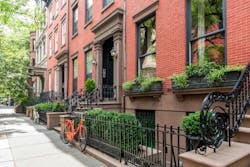Key Highlights
- Multifamily housing is experiencing significant growth, with a focus on tech-savvy renters and retrofit opportunities for existing units.
- Key trends include upgrading mechanical locks to electronic access, mobile credentials, and cloud-based systems for enhanced security and convenience.
- Property owners prioritize integrated, unified access control platforms that support mobile, keyless entry, and analytics for resident behavior and traffic patterns.
During the recent Locksmith Ledger webcast on multifamily (MTF) security, the roundtable discussion looked at opportunities to both locksmiths and security manufacturers. The expert panel included Glenn Younger, owner, Grah Safe and Lock, Wayne Winton, owner, Tri County Locksmith Service and ALOA President, Joseph Harrell, Ohio Valley Regional Sales Manager, ICT, and Jeff Chamberlain, engagement manager, Multifamily, Salto, who focused on the latest trends they are seeing in this area, including upgrading mechanical locks to electronic access control options, the rise of mobile access and credentials, cloud-based access control systems, and how locksmiths are getting work in this area, from new construction to retrofits.
Top Trends
While many companies that are in the lock business are noticing that residential single-family construction is dropping, multifamily “is growing really fast,” says Younger. “Multifamily has about 23 million apartments in the United States. There are permits for another half million or so a year, so it looks like the next couple of years, they're talking about building more than that.”
He continues, “In the existing market is 23 million, 49% of renters are under the age of 30. And they tend to be pretty tech savvy, and that's kind of an interesting thought with owners and managers of multifamily are really focused on retention right now. Whenever there's a little bit of uncertainty in the market, they focus more on retention than growing their revenue. And so there's real strong renter demand.”
As Younger points out, the increase in renters, combined with the increase in the average home price across the U.S., is creating a unique opportunity for locksmiths who are looking to or are already working in this space.
“In the last 20 years, the cost of single-family homes has gone up almost 40%, whereas rentals have gone up 20%, so there should be over the next several years a real strong demand for multifamily units,” adds Younger. “And there's a lack of affordable housing, so there's a lot of things that are really forcing people on staying in a rental unit where in the past they might have moved on to single-family homes.”
While Younger is doing some work on new construction projects, he says that in the last two years his jobs have been 75% retrofit of existing units. “They compete with the new units, and so as they're needing to do things to keep attracting people to their sites, and one of the ways they can do it is by increasing their technology,” he explains. “We like staying mostly in the retrofit world because it's existing customers, which makes it a little bit easier. And there's a real shortage of installers who know how to install stuff on doors. And so even in the locksmith world, we are able to separate ourselves.”
Winton agrees, noting, “I’ve said it before and I'll say it again, we're not in the golden age of access control; we're in the platinum age right now, because pretty much every new construction has some form of access control. You're running low voltage wiring, just like you're running high voltage wiring or plumbing or any kind of utility; it's a basic utility at this point for any new construction. You're going to have a door keypad and some kind of video option usually paired with that. That's almost expected now at the entrance of a multi-family living unit; It's the kids in the generation that are moving out now that are finding those places for their first time.”
Winton points out that he is also seeing multifamily apartment building designed specifically for the older generation.
‘We've got the boomers that are kind of getting to that age where maybe they're trying to set things up for themselves or their kids are trying to find them a good place where they're more involved and around other people and other peers that are their same age, so we see that influx happening as well,” says Winton. “And while it may not be that important these retirement age renters that are moving into those facilities, it's important for the younger generation who might be funding or facilitating that, as their children are going to be the ones that are going to be asking about the access control, video and other technology available based around security and convenience.”
Harrell agrees, noting that as the end user becomes more educated, he is seeing increased activity in both new construction and retrofit opportunities.
“I think what's really driving that is I'm really seeing a very educated end user,” he says. “Whenever we talk to end users, you can tell immediately that they've seen something they think they like or they might want, so they typically have their list of wants, needs and must haves. I think a lot of that's being driven well by the startups who are doing a good job getting into the social media circles and driving awareness, driving a lot of marketing. They're also pushing back through the apartment associations. And a lot of information is out that just typically wasn't out there before.”
As Harrell points out, with the systems available today, a multifamily owner does not have to do a total rip and replace. “There's a lot of conversations about what can be done right now, and then how can that not be a redundant expense in two or three years as we try to scale to keep up with both our pocketbook and what's needed for tenant satisfaction,” he says.
Looking from that perspective of what multifamily management, ownership, or a developer, they are looking for many things.
“First, they want an integrated access control system, so they don't want a separate system for their common areas, and for their doors, and for their gates, their garage,” explains Chamberlain. “They want a complete integrated system to accomplish everything that they want for their access control, for their smart access control -- a unified platform. They also want mobile or keyless access. Their ability to get rid of the keys but still have the resident have choice.”
Chamberlain says video (both access and analytics) for the residents is another big trend. “They're also looking for analytics on resident behavior and that's something else that the smart access control system can give them. They want to know what their traffic patterns are. Where are the residents going? What are they doing? What's important to the residences?”
And with many today doing a month or two lease, or an Airbnb, or short-term leasing, co-living is becoming a huge thing in multifamily. “Having the ability, especially around the colleges and things like that, they want co-living spaces, and then the ability to have remote access and control of that door or residence. Remote access, meaning that I can let somebody in who's coming to my place to come watch a football game with me, but I'm not home,” Chamberlain notes.
Harrell adds that there is continued push from property owners and managers toward “one pane of glass,” he says. “So [you don’t want] to have redundant or multiple systems that your property manager or stakeholders must be able to manage. They’re hoping to be able to have video and access control and visitor management, and now they’re trying to have packaging and think about intrusion and then even some building automation systems or even self-guided tours. So the want and the ask is really great at my level but by the time it gets down to the integrator, it's been paired down and value engineered quite a bit from what actually gets bid and installed.”
Mobile Access and the Cloud
As Chamberlain points out, “Mobile-based access control systems are the fastest growing in the industry, and in multifamily right now. Using smartphones to unlock doors, gates, elevators, amenity spaces, having everything on your mobile device. Glenn said 49% of renters are below the age of 30. That's a big deal … they're the ones that are really into the technology, and they're the ones that are going to be using their phones. I am firmly convinced that eventually everything will go mobile. But for the time being, having choices for the residents is very, very important.”
Looking at the rise in use of cloud-based access control systems, Chamberlain says, “That's also a big thing because, as Joseph was saying, cloud-based integrations or cloud-based allows integrations with other platforms so that they have one pane of glass, one tech stack. They're not having to go into multiple tech stacks. One tech stack gives them the ability to do that. So that's going to be a huge thing.”
He adds that battery-powered wireless locks for the units can help property managers stay within budget. “Especially in retrofits, but also in new construction,” notes Chamberlain. “The cost to run access points throughout the hallways and everything like that can be very prohibitive. So having an offline wireless battery-operated lock for all the units can save thousands and thousands of dollars. So that's really a big thing going on right now. And then something that's up and coming and is being used in very high end, but I think you'll see is the biometric access systems. So facial recognition, everything like that, that's going to be, that's the future and that's where it's going.”
Winton agrees, adding, “Having the credential on your phone and then verifying it with biometrics, I think that's really where things are going. Almost think of it like a two-factor authentication system to where, okay, they have the phone, they have the system. Now do they have a face? Do they have a fingerprint that also matches that? Because there are going to be systems. I mean, anything that gets built, we're going to have a hack for it. Somebody's going to come up with a bypass or a hack for it on the back end. And leading into that, that's where I think systems are going, something that can incorporate a visual aspect, incorporate a biometric aspect, and incorporate an electronic signature as well. And that's really where those layers kind of start to really work and benefit and make this work.”
When it comes to the physical security part of the equation, Winton notes that too often it is overlooked as companies focus more on creating “the best, most hack-resistant system on the planet,” he says. “And a lot of times, companies may be focusing more on that aspect of it and maybe not a physical aspect that could be easily bypassed. Remember, at the end of the day, when we have a natural disaster, when we have a power outage, when we have some other thing that takes power away, we automatically go back to a mechanical-based system. So, we have to incorporate a mechanical system that backs everything up on the back end. Well, we can't leave mechanical out of the equation. And that's really where the locksmith comes into play. The locksmith blends both of those together in a very nice harmony.”
Getting MTF Jobs
Younger says working with existing customers has always been the most successful approach for his company. “The best and easiest customer is one that's already working with you and trusts you,” he asserts. “And that means also that the word of mouth that they give is the absolute best advertising you can get, is that free word of mouth. So, we focus on our existing customers, making sure that they're aware that we do more than just cut keys and re-key locks, that we do these other things. And it's surprising -- we've been at this a lot of years It still surprises me that people are shocked and they say, ‘you can you do that?’”
Younger also points out that there are property management groups in every area of every state. “There's some version of a national apartment association and the one that's in our area is BOMA, the Building, Owners and Managers Association. There's a commercial BOMA group and a residential BOMA, and real estate management companies or HOA management companies.”
Winton agrees, adding, “And you want to know your manufacturer's reps really well, all of them. And you want to be on a first name basis with them, and they need to know who you are and that's where projects come down the pipeline because those homeowner associations and those large apartment associations are reaching out directly to manufacturers. They're saying, ‘Hey, we have a product. We need a product that's going to solve these three pain points.’ And if they have a product that does that, the manufacturer basically did all the selling for you, right? They just want to make sure that a competent, well-trained individual that carries a certain amount of professionalism and integrity then goes and installs that product because I can have the best lock in the world but if I install it improperly, it's not going to function correctly no matter what technology is controlling it.”
About the Author
Paul Ragusa
Senior Editor
Paul Ragusa is senior editor for Locksmith Ledger. He has worked as an editor in the security industry for nearly 10 years. He can be reached at [email protected].




